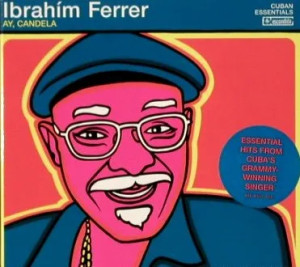 Ibrahim Ferrer, Eliades Ochoa and Omara Portuondo were three of the main participants in 1996’s groundbreaking, multi-platinum Buena Vista Social Club recording that returned Cuban jazz to the world stage. The Cuban state recording company EGREM, through its New York-based Escondida label, has begun re-releasing tracks by these three and other Cuban artists, which laid the groundwork for the explosion that followed Buena Vista. These three and others are being released as Cuban Essentials.
Ibrahim Ferrer, Eliades Ochoa and Omara Portuondo were three of the main participants in 1996’s groundbreaking, multi-platinum Buena Vista Social Club recording that returned Cuban jazz to the world stage. The Cuban state recording company EGREM, through its New York-based Escondida label, has begun re-releasing tracks by these three and other Cuban artists, which laid the groundwork for the explosion that followed Buena Vista. These three and others are being released as Cuban Essentials.
Ibrahim Ferrer, who, sadly, died in May 2005 shortly after finishing a European tour, was more or less the frontman of the Buena Vista group. The lively, twinkle-eyed septuaginarian had a strong, honeyed tenor voice and a lifetime of experience at the semi-improvisational singing style common to the Cuban son and guaracha forms. Ay, Candela is named for one of his trademark songs, which appears here in a version from 1970; as does another hit from the Buena Vista sessions, “De Camino a la Vereda,” here from a 1963 recording. Most of the 14 tracks are from the 1970s and ’80s. The real treats come at the end, oddly enough: the bolero “Santa Cecilia,” a 1983 duet with Carlos Querol, who has a beautiful baritone voice — although the presence of ’80s style electric keyboards is distracting; a solo bolero, “Una Fuerza Inmensa,” which features Ferrer singing in his  lower range with mostly acoustic accompaniment; and the lively “Todavia me Queda Voz,” with lots of percussion up front and sweet horns in the background.
lower range with mostly acoustic accompaniment; and the lively “Todavia me Queda Voz,” with lots of percussion up front and sweet horns in the background.
Eliades Ochoa is one of the younger of the Buena Vista crew, and one who had remained active in performing and recording before that recording’s success. He has fronted the Cuarteto Patria, a long-lived all-acoustic group, since the late 1970s, playing guitar and singing in a sweetly powerful baritone. Formerly an all-trova band from eastern Cuba, under Ochoa the quartet has branched out, adding son, guaracha and bolero to the repertoire, and has also recorded with non-Cuban musicians, including African jazz saxophonist Manu Dibango.
All but three of the 15 tracks on A la Casa de la Trova are from the 1990s; the others are from 1981, including one of my favorites on the disc, “Pregon Santiaguero,” a superb duet. He takes “El Cuarto de Tula,” which Ferrer sang to great effect on Buena Vista, and makes it his own. He strongly rolls his “Rs” throughout, goes off on vocal improvs, and plays plenty of hot guitar solos. Of course that pretty much describes all of the tracks, with some minor variations. “Que Lio Compay Andres” is mellow and sexy, and the backing vocalists are especially lively on “Caminito de Zaza.” One of my  few complaints about this and the other discs is that the backing musicians are not identified on any of the tracks.
few complaints about this and the other discs is that the backing musicians are not identified on any of the tracks.
Omara Portuondo is the only female singer in the Buena Vista sessions, and she’s still going strong at the end of 2005, making plans to record in Brazil in ’06. She was quite popular in the heyday of Cuban jazz, the 1950s and ’60s, giving all manner of dance songs and ballads her special, sexy touch.
The material on Sentimiento is mostly from the 1990s, with some from as early as 1973, and some from the ’80s. Portuondo’s disc has the most sonic variety of these three, simply because she sings in more styles than the others. The bulk of the selections are from a series of 1996 recordings, capturing her as a fully mature singer with an impressive stylistic range. Many of these are sophisticated ballads, but one ’96 track that really stands out from the rest is the upbeat “Echale Salsita.” Some of the songs from the early ’70s demonstrate Omara’s expertise in the filin (“feeling”) style, which emphasized the portrayal of emotion over technical interpretation. Another treat is “Guitarra en Son Mayor,” a lively big-band son from 1984. “Nada Para Ti,” a peppy cha-cha from 1983, would stand up against anything in Carmen Miranda’s catalog. Two tracks I skip are from 1978 and 1980, “Y Mucho Mas” and “Me Acostumbre a Estar Sin Ti,” both lite-jazz songs featuring electric piano, drum machines, lots of echo on the vocals and even an oboe on one track. Blech.
Not “greatest hits” packages then, these releases give an airing to some of the pre-Buena Vista recordings made by these three greats, and are worthwhile additions to the Cuban music catalog.
(Escondida, 2005)
